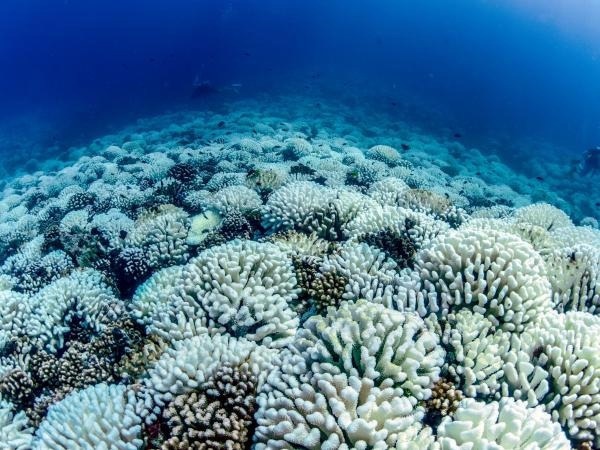Extreme and prolonged thermal bleaching has been experienced by the coral reefs next to the French Polynesian island of Moorea located in the central South Pacific Ocean. This scenario has taken place from April to May 2019.

Image Credit: The Hong Kong University of Science and Technology.
The catastrophe took place in spite of the absence of El Niño conditions in 2019, and it gathered the attention of several ocean scientists worldwide.
An international research group headed by Professor Alex Wyatt of the Department of Ocean Science at The Hong Kong University of Science and Technology has analyzed this interesting and paradoxical coral bleaching episode.
The sudden event was associated with the passage of anti-cyclonic eddies that raised sea levels and concentrated hot water across the reef. This resulted in an underwater marine heatwave that was hidden mostly from view at the surface. The study outcomes have recently been reported in Nature Communications.
The majority of the studies performed on coral bleaching patterns depend on sea-surface measures of water temperatures, which failed to capture the complete picture of threats from ocean heating to marine ecosystems, such as tropical coral reefs.
Such surface measurements performed over wide areas with satellites are beneficial but are incapable of detecting heating beneath the surface that impacts communities living in waters deeper than the shallowest few meters of the ocean.
Professor Wyatt and collaborators attempted to examine the gathered data at Moorea over 15 years from 2005 to 2019. This took benefit of a unique combination of remotely sensed high-resolution and sea-surface temperatures, long-lasting in-situ temperatures, and sea level anomalies.
The study outcomes showed that the passage of anti-cyclonic eddies present in the open ocean past the island increased sea levels and drove internal waves down into deeper water.
Internal waves tend to travel ahead of the interface between the warm surface layer of the ocean and cooler layers below; and, in an earlier study also headed by Professor Wyatt, this has been displayed to offer frequent cooling of coral reef habitats. The currently performed research displays that, due to the anti-cyclones, internal wave cooling was halted in early 2019 and also during a few earlier heatwaves.
Sudden heating over the reef was a consequence, which in turn led to large-scale coral bleaching and the following mortality. Unluckily for local reef biodiversity, the comprehensive coral death in 2019 has offset the recovery of coral communities that had been taking place near Moorea for the past ten years.
A remarkable observation, in opposition to the 2019 heatwave, was that the reefs in Moorea did not experience considerable bleaching mortality in 2016. This happened despite the prevalent super El Niño that was responsible to bring warm conditions and destroying several shallow reefs throughout the world.
The new study illustrates the significance of gathering temperature data throughout the range of depths that coral reefs tend to engage since the potential to anticipate coral bleaching could be gone with a focus on surface conditions alone.
Sea-surface temperature data would help anticipate moderate bleaching in both 2016 and 2019 at Moorea. However, direct observations displayed only ecologically unimportant bleaching in 2016, with heating that was short in duration and limited to shallow depths.
The hard and prolonged marine heatwave in 2019 would have been neglected if scientists only had access to sea-surface temperature data. Also, the consecutive catastrophic coral bleaching might have been ascribed incorrectly to causes other than heating.
The present study highlights the need to consider environmental dynamics across depths relevant to threatened ecosystems, including those due to the passage of underwater ocean weather events. This kind of analysis depends on long-term, in situ data measured across ocean depths, but such data is generally lacking.
Alex Wyatt, Professor, Department of Ocean Science, The Hong Kong University of Science and Technology
Wyatt added, “Our paper provides a valuable mechanistic example for assessing the future of coastal ecosystems in the context of changing ocean dynamics and climates.”
This HKUST-led study was performed in collaboration with a research group from the Scripps Institution of Oceanography at the University of California San Diego, the University of California Santa Barbara, California State University, Northbridge, and Florida State University.
The data underlying this study were made possible by linked long-term physical and ecological observations performed at the Moorea Coral Reef Long-Term Ecological Research (LTER) site.
The long-term analyses performed here, and the simultaneous monitoring of physical conditions and biological dynamics throughout the complete range of depths of the island and coastal marine communities, are a model for future research that aims to predict susceptible living resources in the ocean.
Journal Reference:
Wyatt, A. S. J., et al. (2022) Hidden heatwaves and severe coral bleaching linked to mesoscale eddies and thermocline dynamics. Nature Communications. doi.org/10.1038/s41467-022-35550-5.